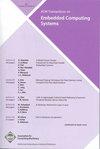赫菲斯托斯:在可重构架构上协同设计和自动化3D图像配准
IF 2.6
3区 计算机科学
Q2 COMPUTER SCIENCE, HARDWARE & ARCHITECTURE
引用次数: 0
摘要
医疗保健是一个关键的研究领域,医学成像在许多应用中都是至关重要的。因此,寻找新的架构和算法解决方案将有利于高度重复的图像处理过程。在这个意义上,最复杂的任务之一是图像配准,它在3D图像堆栈之间找到最佳的几何对齐,并广泛应用于医疗保健和机器人。考虑到这样一个过程的高计算需求,硬件加速器是有希望的实时和节能的解决方案,但它们在软件管道中设计和集成是复杂的。因此,这项工作提出了一个名为Hephaestus的自动化框架,它可以生成高效的3D图像配准管道,并结合可重构加速器。此外,为了减轻软件的负担,我们共同设计了软件可编程加速器,可以在运行时适应图像体积尺寸。Hephaestus具有跨平台抽象层,支持透明的高性能和嵌入式系统部署。然而,由于三维图像配准的计算复杂性,嵌入式设备成为一个受内存约束的相关和复杂的设置;因此,它们需要进一步的关注和定制加速器和配准应用,以达到令人满意的效果。因此,对于Hephaestus,我们也提出了一种近似机制,使这些设备能够执行3D图像配准,甚至在某些情况下达到高性能设备的精度。总的来说,Hephaestus的最大加速提高了1.85倍,效率提高了2.35倍,最大加速提高了2.51倍,效率提高了2.76倍,同时在3D注册上达到了最先进的精度。本文章由计算机程序翻译,如有差异,请以英文原文为准。
Healthcare is a pivotal research field, and medical imaging is crucial in many applications. Therefore finding new architectural and algorithmic solutions would benefit highly repetitive image processing procedures. One of the most complex tasks in this sense is image registration, which finds the optimal geometric alignment among 3D image stacks and is widely employed in healthcare and robotics. Given the high computational demand of such a procedure, hardware accelerators are promising real-time and energy-efficient solutions, but they are complex to design and integrate within software pipelines. Therefore, this work presents an automation framework called Hephaestus that generates efficient 3D image registration pipelines combined with reconfigurable accelerators. Moreover, to alleviate the burden from the software, we codesign software-programmable accelerators that can adapt at run-time to the image volume dimensions. Hephaestus features a cross-platform abstraction layer that enables transparently high-performance and embedded systems deployment. However, given the computational complexity of 3D image registration, the embedded devices become a relevant and complex setting being constrained in memory; thus, they require further attention and tailoring of the accelerators and registration application to reach satisfactory results. Therefore, with Hephaestus , we also propose an approximation mechanism that enables such devices to perform the 3D image registration and even achieve, in some cases, the accuracy of the high-performance ones. Overall, Hephaestus demonstrates 1.85× of maximum speedup, 2.35× of efficiency improvement with respect to the State of the Art, a maximum speedup of 2.51× and 2.76× efficiency improvements against our software, while attaining state-of-the-art accuracy on 3D registrations.
求助全文
通过发布文献求助,成功后即可免费获取论文全文。
去求助
来源期刊

ACM Transactions on Embedded Computing Systems
工程技术-计算机:软件工程
CiteScore
3.70
自引率
0.00%
发文量
138
审稿时长
6 months
期刊介绍:
The design of embedded computing systems, both the software and hardware, increasingly relies on sophisticated algorithms, analytical models, and methodologies. ACM Transactions on Embedded Computing Systems (TECS) aims to present the leading work relating to the analysis, design, behavior, and experience with embedded computing systems.
 求助内容:
求助内容: 应助结果提醒方式:
应助结果提醒方式:


